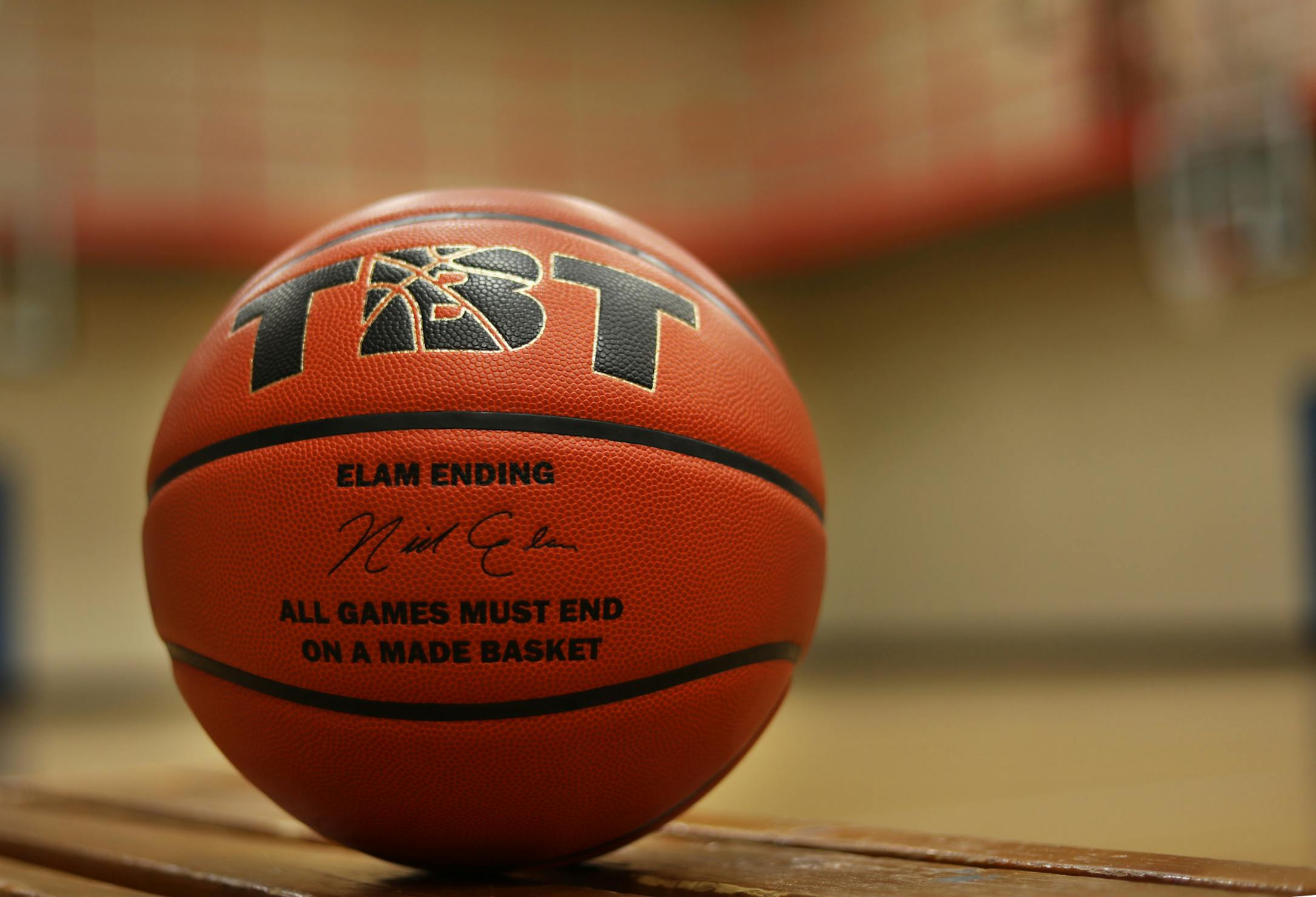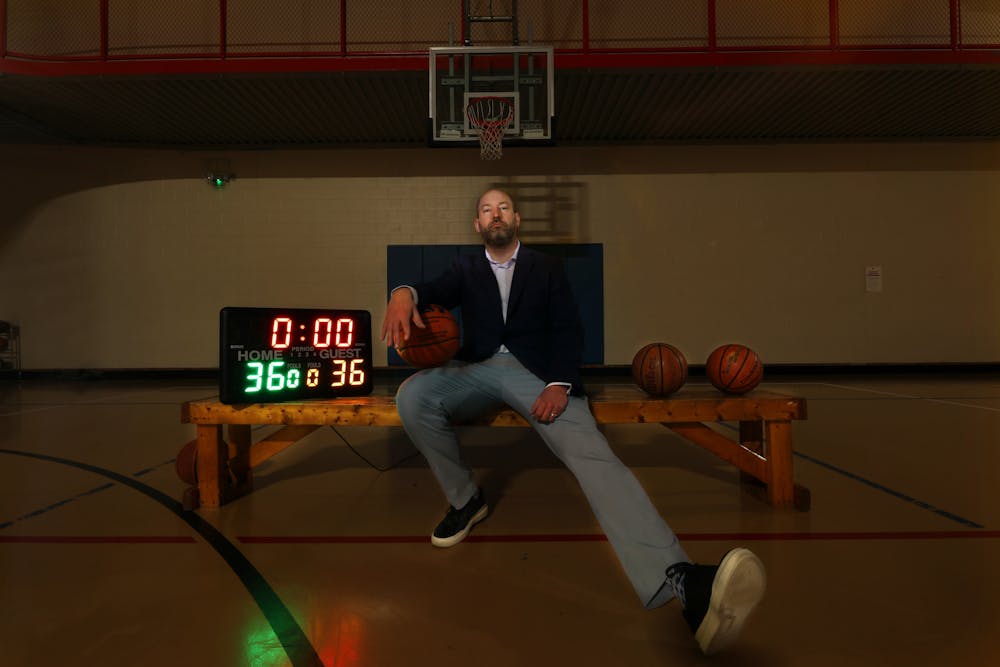A 60-page PowerPoint helped Nick Elam bring his basketball idea to reality.
What began as an idea between his friends watching March Madness soon turned into a 300-page book with one major takeaway: get rid of the clock in the waning moments of the game.
As Elam grew up, he noticed how basketball operated when going into its final minutes; the only way a trailing team could stay in the game is if they deliberately, continually fouled their opponent in an effort to extend the game.
The first time Elam and his friends talked about this “glitch in the system” was in 2004, and they were all in agreement; they did not like how the game flow was ruined by the incessant fouling.
Elam proposed what would become the Elam Ending; during the fourth quarter, the clock is turned off (it can be turned off for the whole quarter or for the last few minutes), and the team that hits the target score, which is the leading team’s score plus a predetermined number of points, wins the game.
“The concept of a clock in basketball is really outdated,” Elam said.
After publishing his findings for the first time in 2007, Elam spent a decade sending his 60-page PowerPoint to many leagues and tournaments, seeing if any of them would show interest in the Elam Ending. It would be a decade before the Elam Ending saw its first user, when The Basketball Tournament (TBT) implemented the system on a trial basis in 2017 before committing to the system full-time the next year.
Since then, interest in Elam’s idea has grown, with the National Basketball Association (NBA) using the Elam Ending under the name of ‘Final Target Score,’ for their All-Star Games beginning in 2020. The NBA’s feeder series, the G League, is currently doing a trial run with the Elam Ending for overtime periods for the 2022-23 season.
“Experimenting with our final target score at NBA All-Star competitions and in the G League has given us meaningful insight into both the benefits and drawbacks of the format,” Evan Wasch, NBA’s head of basketball strategy and analytics, said.
Sixteen years after first bringing his ideas into the world and with his first child on the way, Elam said his journey is “only beginning.”

‘Time’s Up for Basketball’s Clock’
One idea was to punish the fouling team more harshly at the end of the game, and while this would make the option less appealing to the trailing team, he concluded it would not have given “[the losing team] a better option to try to come back in the game rather than fouling.”
The quest to solve this problem took three years until on March 10, 2007, Elam had his breakthrough moment.
Elam noted with a clock present at the most critical point of a basketball game, “both teams are more preoccupied with manipulating the clock.” Therefore, with the clock removed, the game returns to a more fluid and athletic pace and style.
With no clock, Elam said the game becomes less predictable and creates more suspense.
Elam categorized games by whether they played with a clock. Some sports, like tennis and volleyball, play without a clock and accumulate points quickly. When basketball was in its infancy at the turn of the 20th century, it was a low-scoring game. Over time, though, scoring increased.
Throughout 2007, Elam refined his ideas before publishing a book, “Time’s Up for Basketball’s Game Clock,” introducing the Elam Ending to the world.
With his idea now out in public, Elam began the tough work of convincing others in the basketball world his idea had merit.
Years passed, his emails were ignored, but he always thought he was “one day away from a breakthrough.”
The breakthrough would come a decade into his journey when TBT became the first organization to incorporate the Elam Ending in their games.

The Breakthrough
Dan Friel founded TBT with Jonathan Mugar in 2014. Friends since childhood, Mugar was a comedy writer, while Friel was an assistant U.S. attorney; the duo took a leap of faith to pursue TBT together.
The genesis of TBT began with the idea of doing a single basketball game for $50 million; however, the idea transformed into a single-elimination tournament, similar to the NCAA basketball tournament, for a winner-take-all prize of currently $1 million.
“We didn't think there was anything between the NBA and college basketball that filled that desire among the sports fans,” Friel said.
Elam had heard of TBT, and he noted the high-stakes nature of the tournament, how they “like[d] to push the envelope” and how they are considered “trendsetters” due to concepts such as the bracket celebration finding its way into mainstream basketball culture.
In August 2016, Elam sent his 60-page PowerPoint about his hybrid-duration ending to the founders of TBT.
Mugar saw the email Elam sent and immediately recognized the benefit the Elam Ending would have on their league, Friel said.
“We needed something to differentiate TBT from other events,” Friel said, “so this was really a great opportunity for us to try to implement this rule that [Elam] had come up with.”
With the founders of TBT interested in the concept, Mugar sent an email back to Elam. Mugar said the ending was “brilliant.” Then Elam got the news: TBT would be trying out his hybrid-ending duration during the 2017 Jamboree, the play-in games for the main tournament.
Elam realized his concept would be in good hands in TBT; many collegiate and professional players had played in TBT before, such as 2007 NBA Draft first overall pick and Indiana-native Greg Oden, 2012 NBA Slam Dunk Contest champion Jeremy Evans and 2011 NBA Draft second overall pick Derrick Williams.
“I knew that … the concept was going to be tested at a high level of play,” Elam said.
In between getting his doctorate from Miami University (Ohio) and starting at Ball State University, Elam traveled to Philadelphia in June 2017 to see his system used for the first time. The system was in the TBT Jamboree, a play-in tournament for teams wanting to play in TBT. Elam remembered having high hopes, but he was also worried the weekend could be the beginning of the end of his decade-long journey.

By the end of the first day, Elam saw what he was hoping to see. One game went to sudden death. Another game saw a team overcome a 14-point deficit.
“All the different things that I had hoped to see, I got to see on the first day,” Elam said.
As he left Philadelphia, he thought, “This is not the end of this concept, … this idea has life to it. This project has life to it.”
Friel thought so as well. He noted as the games inched toward their target score, the defensive intensity ramped up the “palpable” energy in the arena.
“It's the possession that counts,” he said. “It's not the clock.”
With the success of the test run in the summer of 2017, TBT decided to implement the Elam Ending into all games from the 2018 tournament forward. For Elam, the games were now speaking on his behalf with regard to the Elam Ending.
Friel remembers the reaction the Elam Ending got. Despite some initial skepticism, the fan reaction was largely positive.
“It's easy to be a … cynic, but when you see the Elam Ending live, and you see the exhilaration that everybody has when they actually win these games, it's impossible for people to discount it,” Friel said.
Players on and off the court also had a positive reaction to it. Chris Paul, Phoenix Suns point guard, was a big fan of TBT, particularly the Elam Ending, so he suggested implementing the idea to NBA Commissioner Adam Silver.
Afterward, Paul, then-president of the National Basketball Players Association, brought up the idea to his fellow players. After further conversations, the Players Association came back with their answer; they wanted to use the Elam Ending.
In a Cincinnati airport in January 2020, Elam was about to board a flight to Florida when he got a call from the NBA commissioner’s office.
In that conference call, they told Elam they acknowledged late game play in basketball was flawed, and the Players Association saw a lot of merit in an untimed ending. They then told Elam his system would be used in the upcoming All-Star Game in Chicago, and Elam was invited to see his concept used for the first time in the NBA.

“I was just over the moon,” Elam said.
Next came the 2020 NBA All-Star Game where the Elam Ending was used for the fourth quarter.
“We saw probably the most competitive and intense quarter of basketball in any All-Star game in history,” Elam said. “It was an electric atmosphere.”
Just like its debut for TBT in 2017, the Elam Ending received highly positive reviews after its showing in Chicago.
“I looked on Twitter to see what the reactions were … it was easily 90 to 95 percent positive feedback about the format,” Elam said. “Somebody once told me it would be hard to get 95 percent of the people on Twitter to say good things about puppy dogs and free ice cream.”
After the success of the All-Star Game, it came back in 2021 and 2022. Other leagues are also implementing the Elam Ending, such as the Canadian Elite Basketball League (CEBL).
The Elam Ending Goes Up North
Like other people in the basketball industry, Mike Morreale, Commissioner and CEO of the Canadian Elite Basketball League (CEBL), first heard about the Elam Ending through its successful implementation at TBT. Morreale said he saw the sport as “not really locked into the traditional ways of doing things.”
Morreale noted how with a traditional basketball game with four quarters of timed play, close games can take a lengthy amount of time to end.
“Who wants that?” Morreale said. “Especially [winning] a championship on something like that.”
Morreale first met Elam through TBT’s Jonathan Muger, and after a conversation with Elam, Morreale wanted to implement the Elam Ending in the CEBL.
“Every one of these decisions that he's created are based on data, right?” Morreale said. “We knew that he had certainly done his homework evaluating … thousands and thousands of games [of basketball]. It was more like how do we convince people that this is not hokey, that this actually makes sense, and the only way to do it is to actually do it?”
The CEBL’s implementation of the Elam Ending was significant for multiple reasons; compared to TBT, which is a tournament, the CEBL is a league, making the Canadian league the first league in the world to implement the Elam Ending. Also, the CEBL is affiliated with the International Basketball Federation (FIBA, after the French translation of the name), the worldwide governing league of basketball.

The CEBL first used the Elam Ending in the 2020 CEBL Summer Series, the pandemic-postponed season which was transformed into a tournament.
The CEBL uses a system of the Elam Ending similar to the one used in TBT; when there are four minutes remaining in the fourth quarter, the next dead ball results in the clock being turned off. A target score is then set, which is the leading team’s score plus nine points.
Morreale said the Elam Ending was a “hit right off the bat.” The players told him they loved the concept, and the players said they wanted the ball in their hands to win the game and also to be defending the shooter, so the game didn’t end.
Through “clean[ing] up the ending,” Morreale said it gets down to a backyard style of next bucket wins in basketball.
“This is not only a great way to finish, but it can actually salvage meaningless games,” Morreale said.
What Lies Ahead
In October 2022, Dan Friel, alongside the other organizers of TBT, announced The Soccer Tournament (TST), a spin-off of their successful single-elimination tournament. The tournament, which is a modified 7-on-7 version of soccer instead of the normal 11-on-11 and played on a smaller field, will use a version of the Elam Ending adapted for soccer. Friel had the idea to implement the Elam Ending to soccer because he thought scoring in the sport was “too infrequent.”
“I think the biggest question is whether you have enough scoring in a short period of time to make that work,” Friel said.
Friel created the spinoff due to the “appetite” for single-elimination, high-stakes events like the NFL playoffs and the FIFA World Cup.
“I think soccer is obviously right for that type of opportunity as well,” Friel said, “so there are other opportunities to do something similar and other sports will definitely pursue that as well.”
The CEBL is continuing with the Elam Ending for the league’s fifth season this year, and Morreale said the league is bringing instant replay review for fouls committed during the untimed portion of the game.
“It's becoming more mainstream, and it certainly has benefits, but I think in FIBA, it may take quite a while longer, if ever quite frankly,” Morreale said.
Wasch said that even though the NBA has no immediate plans to implement the Elam Ending for regular season or playoff games, the leagues does expect to use the format in “different settings as part of our continual testing and learning process.”

Elam places the chances of his rules making it to NBA regular season games as “very high.”
“All the momentum has been forward momentum with the concept, sometimes not as fast momentum is what I like, but it's always been forward,” Elam said. “I think that forward momentum is going to continue at some point where we will see it at the NBA level.”
In February 2024, the NBA All-Star Game will return to Indianapolis for the first time since 1985. This game also has significant importance for Elam; 20 years after he had his first conversation with his friends about the “glitch in the system,” his concept is being played in his backyard of the marquee event of the world’s largest basketball league.
He is looking forward to Indianapolis hosting.
“They know how to do [basketball] and do it right.”
Contact Grayson Joslin with comments at Grayson.joslin@bsu.edu or on Twitter @GraysonMJoslin.





